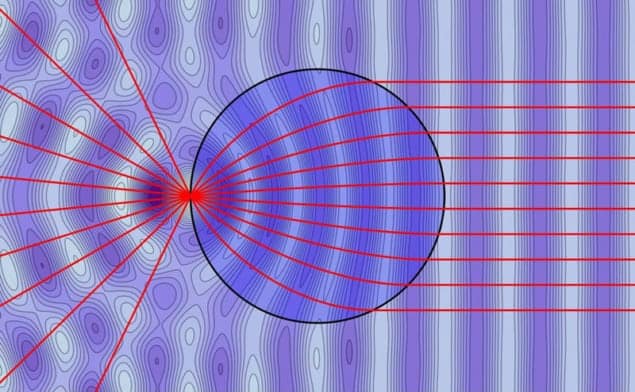
Physicists in the UK have created a Luneburg lens – a lens able to focus light from all directions equally well – on a silicon chip. The device could one day find applications in on-chip Fourier optics, which are used by the telecoms industry to perform tasks from noise reduction to data compression.
Most practical lenses have aberrations, which means that their ability to focus light deteriorates when the incident light is off-axis. But in the Luneburg lens, proposed over 60 years ago, focusing is equally good wherever the light comes from.
But creating Luneburg lenses has proved tricky. They require the refractive index – the property that governs how light is bent by a lens – to vary throughout the device, with a maximum √2 (roughly 1.4) greater than the minimum. With today’s technology it is impossible to dope a material with impurities to achieve this level of refractive-index contrast. Researchers have tried to make approximate versions in the past, but they haven’t been totally successful.
‘Delightful achievement’
Now, Ulf Leonhardt and colleagues at the University of St Andrews have created a Luneburg lens for infrared light with a silicon waveguide. “It was thought to be impossible to build a Luneburg lens in the visible spectrum, or nearby, at a reasonable cost,” says Juan Miñano, an optics researcher of the Technical University of Madrid, who was not involved with the research. “Fortunately Leonhardt is not stopped by any well-accepted thought and is delighting us with this achievement.”
Leonhardt and colleagues’ device is a microscopic piece of silicon, shaped like a contact lens and sandwiched in the middle of two larger polymer and silica layers on a substrate. When the researchers shine a light beam at a wavelength of 1575 nm onto the device, it hugs the interface between the polymer and silica until it reaches the lens, at which point it becomes strongly confined. Indeed, the geometry of the lens waveguide creates an effective refractive index profile that varies from 1.4 to 2.8, focusing the beam to a spot 3770 nm in diameter.
For an ideal Luneburg lens, this focused spot would be half the wavelength, or some 800 nm – almost five times smaller than Leonhardt and colleagues’ measured value. Leonhardt says the discrepancy is due to limitations with the optics, and that a beam covering the entire lens, rather than just part, would produce the best resolution.
More work needed
Igor Smolyaninov, a researcher at the University of Maryland, US, who has also done work on novel lenses, thinks the waveguide Luneburg lens is an “important result”. But he notes that “much more work is needed” before perfect imaging can be obtained.
Indeed, since Leonhardt’s group posted its preprint on the arXiv preprint server, another group has found a route to a Luneburg lens. In a paper due to be published in Nature Nanotechnology (available at arXiv:1101.2493), Xiang Zhang of the University of California at Berkeley and others deliver a Luneburg lens that can focus surface plasmons – waves of electrons in metals.
“What the recent works of these two groups show is that, by using the recipes of transformation optics, the design of devices for doing Fourier optics is much easier and cleverer,” says Francisco Garcìa-Vidal, an optics researcher at the Autonomous University of Madrid. “It is an important step forward in a long-lasting subject.”
The research is reported at arXiv:1101.1293.



